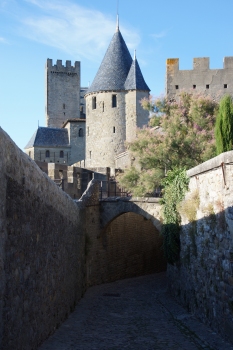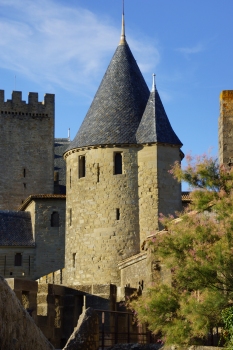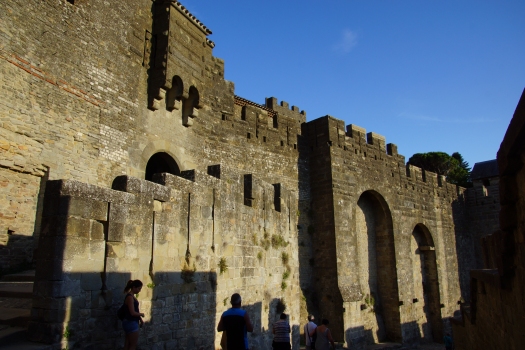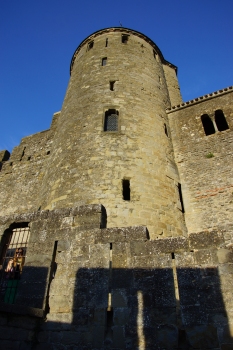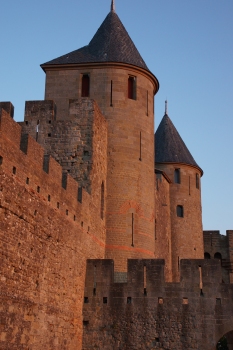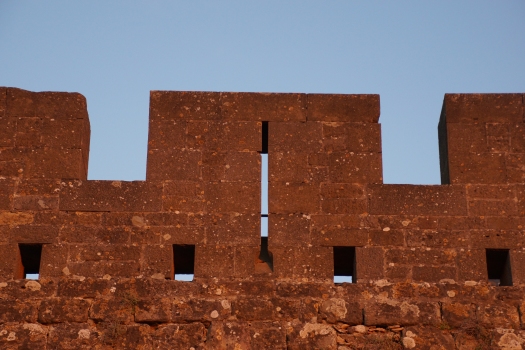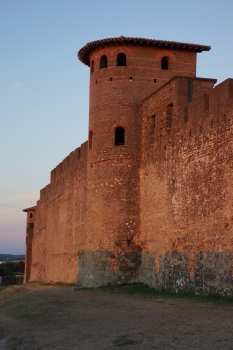General Information
| Status: | in use |
|---|
Project Type
| Function / usage: |
Fortification wall |
|---|
Awards and Distinctions
| 1997 |
part of an ensemble
for registered users |
|---|
Location
| km | Name |
Technical Information
There currently is no technical data available.
Excerpt from Wikipedia
The Cité de Carcassonne (Occitan:Ciutat de Carcassona [siwˈtad de kaɾkaˈsunɔ]) is a medieval citadel located in the French city of Carcassonne, in the department of Aude, Occitanie region. It is located on a hill on the right bank of the River Aude, in the south-east part of the city proper.
History
Founded during the Gallo-Roman period, the citadel derives its reputation from its 3 kilometres (1.9 mi) long double surrounding walls interspersed by 52 towers. The town has about 2,500 years of history and has been occupied in different ages by Romans, Visigoths, Saracens, and Crusaders. At the beginning of its history it was a Gaulish settlement then in the 3rd century A.D., the Romans decided to transform it into a fortified town. The Roman defences were in place by 333 AD, when the town is described as a castellum. The original walls were supported by between 34 and 40 towers, spaced from 18 to 30 metres apart along the curtain wall. Each tower was semicircular in plan and about 14 metres tall. There were probably 40 main entrances to the town.
The Gallo-Roman walls were rebuilt during the town's occupation by the Visigoths in the 5th and 6th centuries, but the original structure remained in place.
Bernard Aton IV Trencavel, vicomte of Albi, Nîmes, and Béziers, introduced a period of prosperity for the city with numerous construction projects. During this period, a new sect known as Catharism sprang up in Languedoc. In 1096, the vicomte of Trencavel authorized the construction of the basilica of Saint-Nazaire with the blessing of Pope Urban II. In 1107, the citizens rejected his sovereignty and called on Ramon Berenguer III, Count of Barcelona to remove him. However, with the help of Bertrand, Count of Toulouse, Bernard Aton regains control of the Cité. In 1120, there is a second revolt, but Bernard Aton re-establishes order a few years later. In 1130, he starts construction of a palace for himself and restoration of the Gallo-Roman fortifications. The Cité of Carcassonne is surrounded by a complete fortification for the first time..
At this time, the city has a large population of 3 to 4 thousand, including the residents of the two settlements below the walls of the Cité: the bourg Saint-Vincent on the north, and the bourg Saint-Michel south of the Narbon gate.
In 1208, Pope Innocent III calls on the barons of the north to mount a crusade against the Cathars, beginning the Albigensian Crusade. The Count of Toulouse, accused of heresy, and his principal vassal, the Vicomte of Trencavel, are the main target of this attack. On 1 August 1209, the Cité is beseiged by the crusaders. Raimond-Roger Trencavel surrenders quickly on the 15th of August in exchange for the lives of the citizens. The town around the Cité is destroyed, and the citizens driven out. The vicomte dies of dysentery in his own chateau on 10 November 1209.
His lands are given to Simon de Montfort, the leader of the crusaders. When he dies in 1218 at the siege of Toulouse, his son, Amaury de Montfort, takes possession of the Cité, but is unable to maintain it. He cedes it to Louis VIII of France, but Raymond VII of Toulouse and the counts of Foix ally themselves against him. In 1224, Raimond II Trencavel retakes the Cité. However, Louis VIII launches another crusade in 1226. From that time forth, the Cité becomes a royal domain. A period of terror ensues, with numerous massacres and the Inquisition.
After 1226, an additional line of fortifications was added outside of the Roman walls. The town was finally annexed to the kingdom of France in 1247 A.D. It provided a strong French frontier between France and the Crown of Aragon. During this period, the inner, Roman walls were largely demolished and replaced, while the new outer walls were reinforced and extended to the south. The new towers built during this work were mainly circular, but two were square. Construction continued into the reign of King Philip IV in the early 14th century.
In 1659, after the Treaty of the Pyrenees, the province of Roussillon became a part of France, and the town lost its military significance. Fortifications were abandoned and the town became one of the economic centres of France, concentrating on the woolen textile industry.
In 1849 the French government decided that the city fortifications should be demolished. This decision was strongly opposed by the local people. Jean-Pierre Cros-Mayrevieille and Prosper Mérimée, an eminent archaeologist and historian, led a campaign to preserve the fortress as a historical monument. The government later reversed its decision and in 1853 restoration work began. The architect Eugène Viollet-le-Duc was charged with renovating the fortress. Viollet-le-Duc's work was criticised during his lifetime as inappropriate to the climate and traditions of the region. After his death in 1879, the restoration work was continued by his pupil, Paul Boeswillwald, and later by the architect Nodet.
The citadel was restored at the end of the 19th century and in 1997 it was added to UNESCO's list of World Heritage Sites. An image of the historic city of Carcassonne appears on the emblem of local rugby league team, AS Carcassonne.
Text imported from Wikipedia article "Cité de Carcassonne" and modified on July 22, 2019 according to the CC-BY-SA 4.0 International license.
Participants
Currently there is no information available about persons or companies having participated in this project.
Relevant Web Sites
Relevant Publications
- (2001): Carcassonne. Le temps des sièges. CNRS éditions, Paris (France), pp. 128.
- (2003): La cité de Carcassonne. Monum. Editions du patrimoine, Paris (France), pp. 64.
- : La Cité de Carcassonne (Deutsch). Monum. Editions du patrimoine, Paris (France).
- : La Cité de Carcassonne (English). Monum. Editions du patrimoine, Paris (France).
- : La Cité de Carcassonne (español). Monum. Editions du patrimoine, Paris (France).
- About this
data sheet - Structure-ID
10000519 - Published on:
27/05/2004 - Last updated on:
09/09/2017


